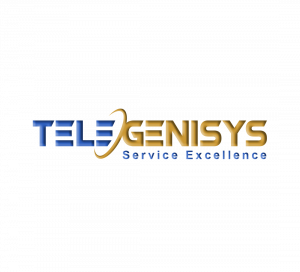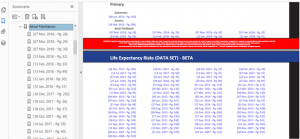Telegenisys releases Custom Datasets for Life Underwriters
Telegenisys uses customized reference datasets in summaries that aid life underwriters to improve the accuracy of their valuation.
FAIRFIELD, CALIFORNIA, USA, May 3, 2021 /EINPresswire.com/ -- Telegenisys' Visualize Medical Records (VMR) system now includes customized life expectancy datasets that help to process more comprehensive and accurate summaries and chronologies.Reference Datasets for life insurance and life settlement companies are designed for deep referencing in medical records for rapid understanding of medical information for policy valuation in life settlement markets.
Disease conditions are divided into ratable and non-ratable conditions. Ratable conditions are the ones that will affect the quality of life of the insured. These include cancers, diabetes, renal conditions, hepatic conditions, cardiac conditions, respiratory conditions, conditions affecting the nervous system, and more. Non-ratable conditions are the ones that do not really affect the quality of life and a person can live with them. These conditions include skin conditions like psoriasis, eczema, acne; minor gastric disorders; cholelithiasis, nephrolithiasis, etc.
This assessment involves not only the disease conditions but also the insured’s lifestyle, fitness and frailty factors, mobility, social history, and family history.
Telegenisys has developed customized reference datasets that help the underwriter to quickly look through all the data at one glance to assign the ratings. Here is an example of a patient suffering from atrial fibrillation. This is a cardiovascular condition and is a primary condition as it can lead to more severe effects.
Telegenisys offers summaries that make review easier for the underwriter. The summary has all the rateable conditions’ information listed under primary conditions and the chronology of all the relevant events. Our team of experienced summarizers weed out the repetitive and non-relevant episodes and list them in a word document. Each entry has a hyperlink to the original pdf document and bookmark in the VMR chronology output. The underwriter need not take the word of the summarizer; he can verify the details without scrolling a single page, the hyperlink will take them to the respective page.
Summaries by Telegenisys are customizable to suit various users. We understand your requirements and offer you the solutions. The user can request various changes that ensure ease of use.
Primary condition – Atrial fibrillation
-------------------------------------------------
In Image 1, you see all the listings of atrial fibrillation. All the reports where this is mentioned are listed together in chronology. The underwriter is able to click the hyperlink and go directly to the report and review. He is able to see the date that this condition was first mentioned and the last mention. Without scrolling through even a single page he has the onset (if the record is available) and the current status. He can click on the pages and assess his rating. To see the progression of the condition he can click through all the pages and read through as required. The underwriter no longer has to be in doubt if he got the dates correct, did he miss anything out, if this condition is progressing aggressively or is it unchanged over several years.
Atrial fibrillation followed from November 4, 2006, to March 7, 2018. There are more than 70 references where the first mention says chronic atrial fibrillation with embolic risk, and the latest one shows that there was cardioversion in 2003 showing that the condition predates the first mention. If it needs further evaluation, requests can be sent out for more records.
(See: Image 1 - Atrial fibrillation)
The EKG reports are listed under a single header. The reviewer can click on each one and quickly move on to the more relevant ones and leave out the unchanged screening reports.
Primary Condition – Cancer
-------------------------------------
Cancer of Colon – This client had colon cancer in December 2015. He underwent treatments likely surgery and chemotherapy. He appears to improve and the cancer is in remission considering he is undergoing screening in January 2017. All these observations in one look reduce the pressure of the workload and the reviewer can give 100% of his effort to only the review and not stress over tight deadlines. Evaluation and diagnosis of Colon cancer – MRI reports from December 2012 is a screening report. Colon cancer was diagnosed in January 2009.
Treatment of colon cancer – Image 2, shows the tumor in the colon was resected and the patient has a stoma. The quality of life is compromised and is unable to be as active as before cancer developed. Surgical History – The patient has also undergone hysterectomy, cardioversion, and hip surgery with femur rod fixation. All these verification are directly done from the source file without rushing page after page.
(See: Image 2 - Treatment of colon cancer)
Neoplasm of the skin – If you see the patient developed skin cancer in February 2017. To review the efficacy of treatment, click on the next follow-up date July 2017, to see how he is doing.
Preventive Monitoring
-------------------------------
A family history of breast cancer is noted and further investigation is warranted to find out the type and details of the insured is also at risk of developing breast cancer.
Mammogram screening – This screening mammogram shows there is no breast cancer until March 2015. All mammograms are listed together to make the review easy and fast.
Hemochromatosis – Patients with hereditary hemochromatosis (HH) are reportedly at a 20-200-fold risk of intrahepatic cancer. This patient’s records need to be investigated further for any further risk and if reports are missing they can be requested.
In the above examples of different types of cancers/cancer risks are listed under one heading that shows the evaluation – treatment – outcome.
Primary Condition - Coronary artery disease – aortic sclerosis - leading to hypertension – other pulmonary and cardiovascular diseases.
Cardiovascular conditions – Like cancers all cardiovascular conditions are listed under one heading to make evaluation and analysis easy and quick.
(See: Image 3 - cardiovascular conditions listed)
The life expectancy dataset is designed to separate the primary conditions and the secondary conditions, i.e. ratable and non-ratable. This feature helps the underwriter to navigate easily and smoothly through the reports without frustration or losing something you found on a page or segregating the reports to uniquely identify the various conditions and the treatments and effects.
About Visualize Medical Records
-------------------------------------------
Telegenisys uses VMR to create summaries with accuracy and in less time as compared to doing this manually. The structured format and availability of verification at every stage ensure quality output. VMR supports the analysis of medical records and makes it simple, readable, and gives the events a flow so the reviewer is able to look through the data from every angle before reaching his conclusions.
Visualize Medical Records software has been developed over the last two years to organize and index thousands of medical records into a readable format. VMR converts a jumbled assortment of medical records in pdf formats into an understandable organized medical chronology. The unsorted medley of thousands of pages of medical records from various sources, from providers of different specialties, from different time frames, for a single patient is a challenge to organize manually. It is difficult to see second opinions and alternative treatments of a particular condition when the order skips dates by months and sometimes even years. Besides the rearrangement messes with the integrity of the original records that may be needed to use as exhibits in a legal scenario.
The structured data facilitates analysis and comparison of multiple cases most commonly used by clinical research companies and tort lawyers. These observations can be reviewed graphically in excel formats. You can use a filter and view all data in a single view. Every entry in the structured data is hyperlinked to the original record for detailed review. The use of hhs.gov databases the structured data chronologies present medical information with unquestioned authority and clarity. This structured data allows clients to use, update, and evaluate medical facts in their software.
The organized record is available electronically and stored in a secure cloud storage facility provided by Telegenisys, so it can be accessed easily via any device at any location.
Company
--------------
Telegenisys Medical Technologies Group is a division of Telegenisys Inc. a Delaware company with primary offices in Fairfield California. The group operates on two continents with a second office in Pune India. This group has worked with medical records for over 15 years and works on over 2 Million medical record pages per year. The group is composed of a variety of medical personnel and data scientists. The primary purpose of the technology group is to develop simpler ways to understand and measure medical outcomes.
Contact information
----------------------------
Mark Merani, CEO
Telegenisys Inc.
+1 844-903-0777
email us here
Visit us on social media:
Facebook
Twitter
LinkedIn
Telegenisys releases custom datasets for life underwriters



